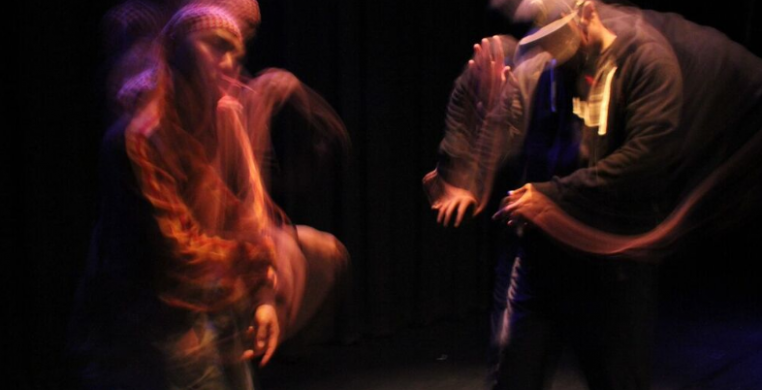East coast Hip-Hop meets west coast Butoh in Rennie Harris and Michael Sakamoto’s multidisciplinary dance dialog, “Flash,” performed this past weekend at The Dance Center of Columbia College. The two forms, according to program notes, arise out of “the body in crisis,” and a physical manifestation of that crisis that radiates outward from the center of the body, less concerned with external form than with internal impulse.
The play between stillness and motion, fast and slow, stopping and starting, and sudden and sustained movement is at work in both forms, calling attention especially to varying intervals of stillness between moves. Grotesquerie and pain underly aspects of both traditions, which grew out of social protest in their respective subcultures.
“Flash” begins with a blown-up photo projection of a small home office and a view out its window of a blossoming tree. There is a cluttered desk with a chair pulled out as if someone has left and will return momentarily. You can almost feel a gentle breeze rustling the curtains as music plays. And plays. And plays. The image creates a contemplative environment, conditioning audience expectation for a meditative experience. The stage remains uninhabited. Two chairs, placed diagonally opposite each other, heighten anticipation of the performers’ entrance.
Finally, after an exceptionally long wait, Harris and Sakamoto make their slow entrance. The two move toward each other. Harris, shrouded in a dark hooded sweatshirt over a baseball cap and baggy pants, falters with a pained, tentative gait, while Sakamoto moves trance-like in colorful bandana head gear, jacket and workout pants. They come together center stage and stand in stillness next to each other. A tape plays of the two men’s voices in dialog about the creative process, acknowledged by Harris as overly intellectualized but necessary to put words to the work. Irony or overkill, I wasn’t sure. “Who are you when you dance?” Harris asks. Ah, I tell myself, this will be a dance about being and transformation. I continued to hold out expectation for movement, any movement, that would enlighten me.
Harris has built a formidable reputation on his remarkable innovation as a dancer and choreographer who catapulted hip-hop onto the concert dance stage. Sakamoto, no slouch on the international dance and theater front himself, tours extensively and has won numerous awards for his transdisciplinary work in dance, theater, media, and photography.
To say that minimalism defined the artistic structure of “Flash” would be one way to acknowledge the zen-like absence of activity and minimal evidence of the dance forms purportedly under investigation throughout this performance. Perhaps that was the point. At its best, we got glimpses of Harris’ former brilliance, sporadically coming to life in paroxysms of upper body “popping,” “breaking,” and “locking,” and Sakamoto transcending the ordinary with extraordinary concentration and exquisite control. But too much of the hour was consumed with trivial digressions, heavy on trite dialog and light on movement ideas centering around the two men coaching one another in the clichés of each other’s cultural idiom and humorously failing at it.
There is a point of convergence in the creative process where concept and form crystalize into something greater than itself to become a fully-realized work of art in performance. “Flash” promises both a conceptual and physical dialog between the two contrasting dance forms and their respective contrasting cultures. It promises “to address the intersection of urban and environmental crisis, social resistance, and identity.” What a wonderful idea! But “Flash” remains largely mired in its conceptual aspirations, promising more than it delivers.

